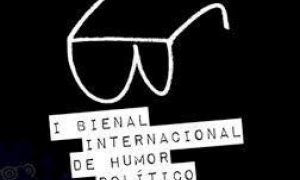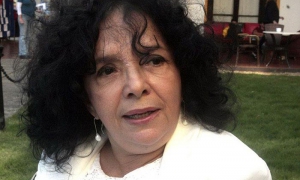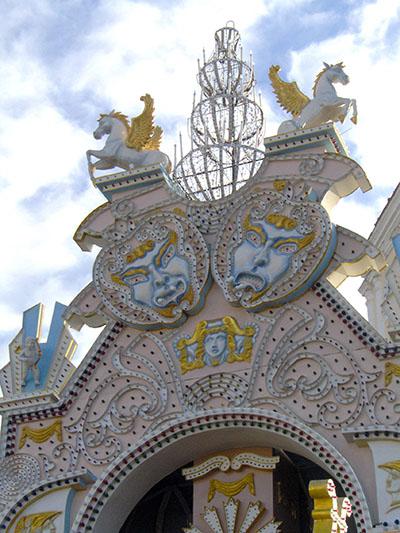
WALKING through the historic center of the town of Remedios at this time of year, one notices a very strange phenomenon occurring. The neighbors pass their time arguing, declaring themselves either supporters of San Salvador (St. Saviour) or El Carmen (Our Lady of Mount Carmel); they wear red or brown clothes, humming the songs from one neighborhood or another. These are the times of the Parrandas - traditional carnival-like street parties which take place between December 16-24, and since 1822 have divided the city and reached incredible levels of popular creativity.
San Salvador, with his symbolic rooster and red flag is positioned north of the Plaza Isabel II. El Carmen sees the southern part of the city painted brown and her sparrow hawk flies over the rooftops of the Iglesia Mayor church. Everyone participates, making lanterns, banners and costumes.
They compete on three fronts: with floats, works of art in the squares (structures over 80 feet tall, adorned with lights) and fireworks. The teams consist of local, amateur artists, but the themes of the works and the floats range from ancient history to the most demanding classical literature. People recite by heart the passing of the Persian Empire, or talk about Greco-Roman civilization. The Parrandas are a school, where art is forged in the heat of competition between two irreconcilable brothers.
FRANCISQUITO AND HIS FOUR TIN CANS
The cans are growing with rage each night. What a very strange way to get right with God!
Popular song in Remedios, circa December 1878
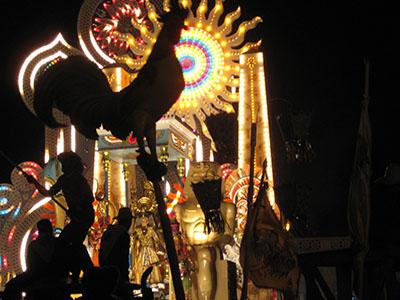
It is said that in the early nineteenth century, the town was divided into the following eight neighborhoods: Buen Viaje, Camaco, La Laguna, San Salvador, La Bermeja, La Parroquia, El Cristo and El Carmen.
Back then the traditional Christmas midnight masses were celebrated, but turnout was low because of the cold, rain, poor lighting and impassable mud in the streets. Father Francisco Vigil de Quiñones, a priest from Asturias who officiated in the parish of San Salvador, came up with the idea of waking parishioners by making a lot of noise, thus forcing them to attend mass. Hundreds of children armed with noisemakers, guayos, cans filled with stones, bars, cowbells and firecrackers, ran through the streets led by the priest.
Francisquito, as he was called by the people, died in 1833, but his legacy lived on. The eight neighborhoods took to the streets to rowdily awake each other. Such was the uproar that a proclamation was issued in 1835 by the Attorney Don Genaro Mejia banning revelers from going out onto the streets before four o'clock in the morning. The infernal orchestras, as they were described by the authorities, defied all obstacles and grew into a mass phenomenon.
In 1850, two women took over the organization of the festivities and grouped the bullangueros (revelers) into two camps: the Sansarices (followers of San Salvador) and the Carmelitas (supporters of El Carmen).
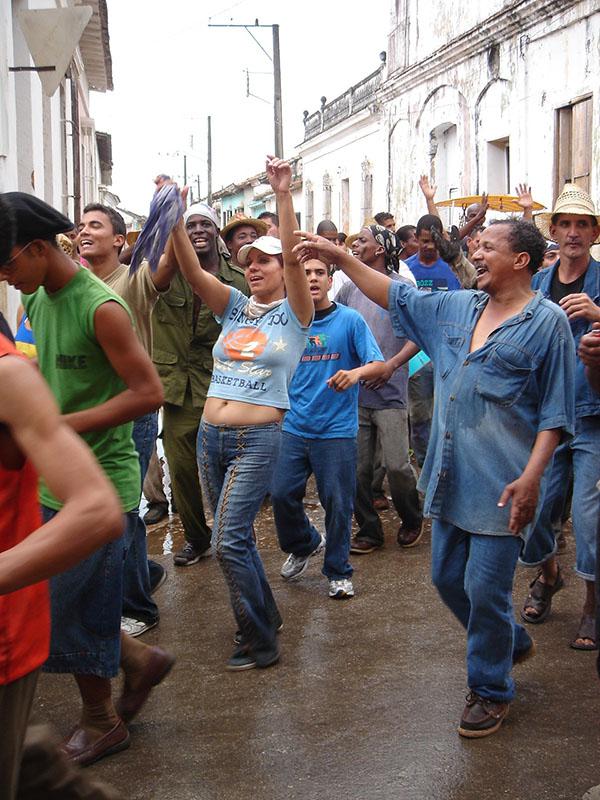
Rita Rueda and Chana Peña were the matrons of the Parrandas, they organized choirs of singers, guitarists, drummers and bandurria players. In 1871, two Spaniards took over: Cristóbal Gilí Mateu on the El Carmen side, and José Ramón Celorio del Peso for San Salvador.
The competition intensified, the use of huge kites during the festivities began, together with the appearance of paper balloons, which floated using helium gas. The Polkas of both neighborhoods became the anthems that accompanied the triumphant floats and carriages.
In the late nineteenth century the rivalry between the two sides was fierce. Some chanted “Long live El Carmen and her light and her flag with fervor, and death to the scruffians of the San Salvador neighborhood.” Others responded: “Where is San Salvador going, with the night so dark, I will open the grave as El Carmen is already dead.”
The Parrandas spread across north central Cuba, to towns such as Camajuaní, Caibarién, Vueltas, Encrucijada, Zulueta, Chambas, Yaguajay, Placetas and El Santo.
There is so much love for the tradition in Remedios, that only on rare occasions has it not been celebrated: from 1895-1899 due to the war of independence against Spain, in 1932 and 1933 during the dictatorship of Gerardo Machado Morales, and between 1956 and 1958 due to the tense situation in the struggle against the tyranny of General Fulgencio Batista. Not even in the Special Period were the Parrandas suspended, with the Revolution considering them one of the three national celebrations, and Cultural Heritage of the Nation from 2013.
WIND AND MYSTERY
Memories of my childhood include the winds of the Parrandas, bringing with them the December cold and the smell of the workshops, glue and paint, fresh plaster and damp wood. The artworks emerged to shine during an early morning and then plunged into the forgotten memories of the 500 year old city.
I begin by visiting the San Salvador workshop, located at the north end of town. They don’t always allow people access, because the work is done in the utmost secrecy, to prevent the other side from discovering anything and taking the initiative.
That cold air of the Parrandas, mixed with mystery, seems to motivate and energize the teams of artisans: carpenters, decorators, laborers, electricians. A few hours before the party there are still finishing touches to be made, the crowds laugh and begin to load the pieces, an enthusiastic siren sounds relentlessly, the ringing of hammers and drums can be heard.
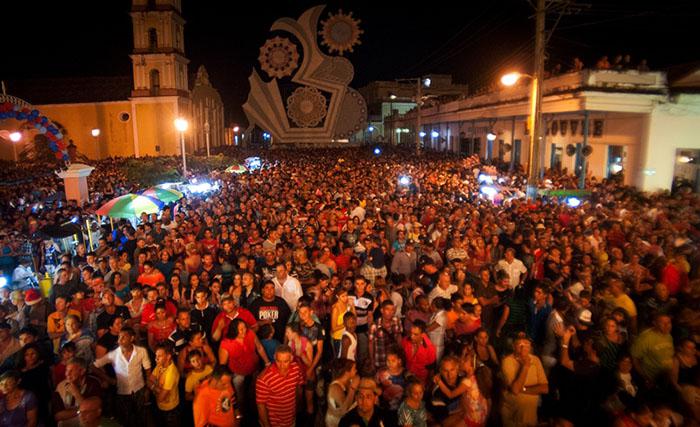
“I’ll only give you the necessary information, without compromising the surprises we have in store.”
The neighborhood president speaks as if he were commanding an army.
“Here we have been working since October,” he tells me, “but I assure you that this year, like the last, we have victory in the bag.”
Francisco Reinaldo Gutiérrez, goes on to address the difficulties of carrying out the Parrandas. Last year for example, the transformers couldn’t handle the electrical load and their float was left in the dark.
“That's our Achilles heel, we had not yet reached an agreement with the Electric Company and had to buy low energy bulbs to light up our works. Aside from that, the support provided by the Municipal Party Committee, and that of Culture and the government itself, proved efficient. The fuel arrived on time and the budget, although somewhat delayed, was decisive. Today we are concluding our efforts with quality Parrandas and a high volume of fireworks.”
When I ask him about the exact number of rockets to be set off, he is silent and smiles, this is the best kept secret of the festivities. This year, San Salvador has a Roman themed float, the “Calígula”, decorated in blue, white, red and gold. The plaza piece, 80 feet high and 50 wide, is called “The Return of Triton” and is covered with some 12,000 colored bulbs. Its creator, Ignacio Rojas, took just fifteen minutes to design it yet they are sure of victory.
“They know they have a hard fight ahead,” José Enrique Jiménez tells me, working in the El Carmen workshop.
The Carmelitas want to settle the scores, and have designed a colossal plaza piece measuring 88 feet high and 60 wide, entitled “The Adventures of Pinocchio”, based on the literary classic by Italian Carlo Collodi. Kaleidoscopes, wooden dolls and children's games cover the work. Jiménez explains that their float has an Egyptian theme, demonstrating the mastery of the Remedios school of decor and costume.
“And fire was always the strength of our neighborhood, a tradition that we want to recover this year. The opponent needs to be careful, because what El Carmen brings is to be respected.”
The Carmelitas have a reputation for defending their neighborhood to the extreme. They have always been distinguished by their skill in producing the boldest plaza pieces.
There is just one thing not up for discussion by a reveler: the invincibility of their neighborhood. As such I’ll not make any comment and leave it to the central plaza to have the last word.
PARRANDAS IN THE PLAZA
The plaza is the site where the mystery is revealed. The works are constructed, piece by piece, watched over by the enthusiasts, who argue furiously in the four corners of the square. Some say that San Salvador has a more complete piece, with more thorough decoration. Others advocate for the monumental character of the piece by El Carmen. There is no jury, no one provides a conclusive ruling, the expectation is eternal. The central square is packed at six in the evening on December 24.
Every now and again a rocket is lit and the crowd sounds like a wave, while enthusiastic children run around. The drums and ringing of bells announces that the eternal rivalry between neighbors has already commenced. San Salvador appears with his white cock, a collection of flags and colored lanterns, flares go off. The people sing traditional rival rumbas. While the improvised musical group passes through the square, thousands of rockets cloud the evening, which is already turning in to night. Then the trumpet sounds, and it’s the turn of the Carmelitas.
“Here I await you Sansarí, to give you a thrashing,” the revelers chant and the followers of the neighborhood jump up onto the park benches and join them, this time passing from the La Pastora alleyway to the center of the square, the traditional entrance of the El Carmen parade. A deafening combination of rockets, lights and cheers from each side signal the beginning of the tradition.
This will continue all night and into the morning, until both neighborhoods declare themselves the victors at ten o'clock on December 25, joyously parading through the streets surrounded by the scent of gunpowder and an always mysterious air.
Such is this eternal tradition.


